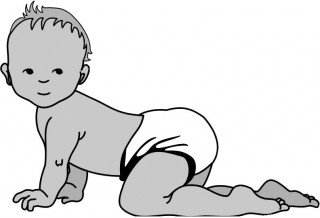Parenting: Babies and Movement
by Harald Breiding-Buss

Compared to all other mammals, human babies are exceptionally underdeveloped and helpless—so much so that it seems amazing that the human species has survived at all, what with our low reproduction rate and the kind of effort required to raise a child to maturity. There must be a pretty strong biological advantage that outweighs those drawbacks.
That advantage is the human propensity to learn, which is strongest in babies and toddlers. It is our underdeveloped brain at birth that gives us the ability to grow into the most diverse natural and social environments; no other mammal species managed to spread around the whole world on its own volition, being able to manage to survive in almost every ecosystem.
Babies are wired to learn about the environment they are being born into, and it is the parents who are doing the teaching, most of it without realising it.
The key to early learning is movement. Movement triggers those all-important brain connections, and it has a lot of more obvious effects as well: a baby that can move around can explore their environment much better than one that can’t, learning in the process. And it is the fine motor skills in baby’s hands that let them explore and manipulate objects.
But babies are born with neither the ability to move around or to hold an object in their hands, so the exposure to opportunities to move around, and things to explore, has a lot to do with how ‘natural’ you are with those physical skills for the rest of your life, and what your problem-solving abilities are going to look like.
A whole small industry has sprung up around baby movement. I remember taking my children to ‘kindy gym’ for 2-4 year olds, where they basically set up a little obstacle course with tunnels to crawl through and low benches to jump off from (remember the ‘motorbike landing’?). One theory holds that crawling is essential to make connections between the two hemispheres of the brain, and they advocate that babies crawl for at least 3,000 hours in total before moving on to walking.
All that creates quite a bit of performance pressure: A colleague once broke out into tears at a baby movement seminar after confessing that her kids had been ‘bum-shufflers’. Therefore, the Early Childhood Development experts with the Ministry of Education warn against ‘forced development’, ie pushing your baby beyond what they are ready for. At least one of them is highly skeptical even of the now widely promoted ‘tummy time’, believing this is not a natural position for babies to be in.
One thing is certain, however: whatever you do or don’t do has a very big impact on that ballooning brain of your baby. Getting conflicting advice in this area simply makes decision-making all the more nerve-racking.
For an average middle-class family there is very little danger of physically over-extending your baby. The opposite is generally the problem: babies are surrounded by toys within arms reach, providing little motivation to reach out further. There are baby rockers and other devices that will keep baby comfortable in a largely stationery position. Much of that has to do with attempting to keep the baby safe—it’s that very drive to learn and explore that causes a lot of accidents. So parents are told that unless you can give junior your full and undivided attention, baby needs to be put somewhere safe—and constricted.
Babies and toddlers are also often not given a suitable range of things to explore: toys for littlies tend to be made of plastic because of baby’s propensity to suck on everything they can get their hands on, but plastic is the material you are using least often to build or manipulate things with later in life. Plastic is hygienic—but otherwise pretty useless.
One of the advantages in helping babies and toddlers to build their physical skills is that it is so much fun for everyone involved. You’ll get lots of laughs and giggles when you play-fight, jump, roll on the floor or walk backwards together. It’s quality time at its best and can make for an excellent distraction tool as well for those times of the day when junior seems a bit grumpier.
In a lot of more working class families babies are stimulated far more and, generally, have more rapidly initial development. There is a lot more coming and going in those households, more men as well as women interacting with baby, fewer toys and gadgets and also usually less focus on safety. That exposes the youngsters to more risks, but also vastly increases their range of experiences.
One of the drawbacks of growing up in a busier environment like this is a much shorter attention span, which in our world is the biggest stumbling block to a decent career and gets you into all sorts of trouble. The key here is one-on-one time, with no radio or TV, where baby has the parents’ full attention for at least 15 minutes (more when older) at a time, and preferably several times a day.
So what about those ‘music and movement’, ’baby yoga’ and other classes. Do they deliver what they promise?
Probably not unless they complement what you are doing at home anyway. It is exceptionally difficult to try and bring out skills in your child that are not otherwise a part of your life, unless you consciously work on it several times every day. You are most likely to succeed if you do something that you yourself enjoy very much, because then it will become part of your daily life.




